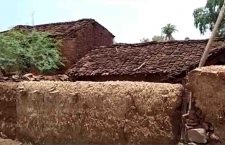On 13 October 2014, Mahoba district in Uttar Pradesh was declared a ‘dark zone’. The term conjures up images of gloom, despair, and perhaps even death. And in Mahoba, the situation is exactly as grim as it sounds. Dark zones are areas demarcated by the government where the over-exploitation of groundwater is acute, and where the withdrawal and usage of water exceeds its recharge. Dark zones have sprouted across the country, with Uttar Pradesh, Punjab, Gujarat, Andhra Pradesh and Tamil Nadu attempting to grapple with the crisis. However, in Mahoba, the residents allege that the administration has taken no steps to tackle the issue of water shortage in the region.
According to a World Bank Report, around two-thirds of India’s aquifers will be in a critical condition in the next 20 years. Groundwater is a crucial resource for India; over half the irrigated agricultural areas and 85% of our potable water is dependent on groundwater.
In Mahoba, the incessant creation of bore wells and hand pumps has further reduced the groundwater levels in the region. According to the Water department, this year the groundwater table has receded by three metres.
Still, the administration remains careless and negligent. Water is wasted through mundane activities, such as cleaning various government centres. If the situation persists, it could precipitate a massive crisis for the people of Mahoba.
Manoj Kumar Shah, Assistant Engineer states, “I would definitely call this area a dark zone. If water levels in the region are within a particular critical level, it is categorised as a dark zone. The category ‘over-exploited’ is used if water usage is above the critical category—It involves excessively using an already critical or scarce resource. Whereas, a ‘critical’ situation arises when the usage of water is exactly at the level available—when we effectively collect a 100 litres and use exactly 100 without saving anything.”
However, the residents of Mahoba have not been informed of these categories or terminologies. For them, their daily struggle to procure water overshadows other considerations. 60-year-old Urmila complains, “It is so difficult for me to fill a bucket (around 150 litres) of water…I get so tired! One drum is needed for household chores, and one for the temple. In a day, this one bucket of water runs out so quickly. More than one drum is needed to do both household chores and for bathing. But if water is unavailable, what can I do?”
Yashoda, a concerned resident is despondent, when she tells us, “There is definitely a problem, because water comes every alternate day. Some days, water is supplied everyday, but mostly it comes every alternate day. We are provided with one drum of water, when we actually require 4.”
Ramesh Chandra, the Engineer of the Irrigation Department sheds light on the issue, “Yes, Mahoba has been declared a dark zone. This means that we can’t use water for irrigation, but only for drinking purposes.We need drinking water for survival, so we’re permitted to use it.” Groundwater sustains almost 60 per cent of the irrigated land in India. Most districts in India today have larger shares of irrigated land under groundwater irrigation than under surface-water irrigation. This ominous change in water use patterns in India has been extremely rapid since the 1970s. Reversing this trend, then, clearly seems to be the strategy of choice in Mahoba.
Ramnarayan, the clerk at the district Water Department is confident that the administration has this dire situation under control: “Yes, the water has reduced this year, by approximately 10 ft. This definitely indicates a severe water problem. But the alternate support we have arranged for people has controlled the situation. Water is supplied almost every alternate day to people.”
Ramesh Chandra is quite sanguine about what definitely sounds like a doomsday prophecy, ‘For the last two years there has been a drought-like situation. There have been problems with water supply, and even the water level has further reduced. We have two MLAs, and under their aegis, we brought over 100 hand pumps to this area. We have surveyed the hand pumps and their condition. We came to the conclusion that a hand pump should be constructed at a distance of 75 meters from the other hand pump, and a population of 150 is required. The location list is with us and we shall install the hand pumps very soon.”
However, skepticism about these plans is rife. Tara Patkar, an engaged and active citizen states, “I have observed in these 10-12 years that one year it pours, and then for the next 2-3 it doesn’t rain, and we have much less water than we need. This causes uncontrolled tapping of the groundwater. In 2007, the area saw a drought-like situation. At that time, the government installed many hand pumps. The problem was not the construction of these pumps, but the fact that they were installed near wells. This caused the destruction of the wells. People stopped using the wells, and because of the pumps, the regular channels through which water would travel to the well were disturbed.” The rampant and negligent construction of hand pumps is one of the leading causes of the contamination and depletion of groundwater tables in India. Yet, the administration is conveniently patting itself on the back.
Sahdev, SDM Mahoba states, “We have arranged for water for people with the help of 160 tankers. We have put the tankers in the right locations for easier access to water. More tankers are being arranged for people in higher areas where pipelines cannot reach.” Thus, in Mahoba, the administration seems more keen on quick-fixes than legitimate, systemic policy changes. Steps such as the construction of hand pumps may appease the populace temporarily and provide relief, yet will herald further ‘darkening’ of Mahoba in the years to come.


